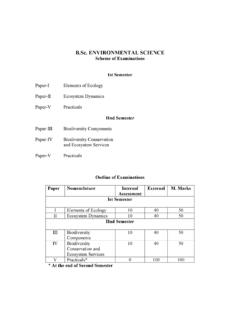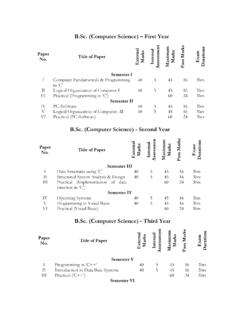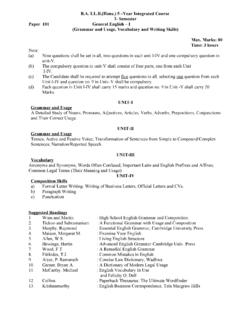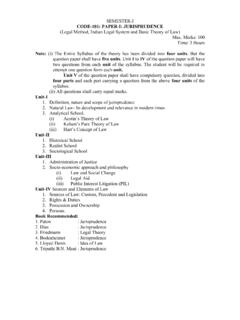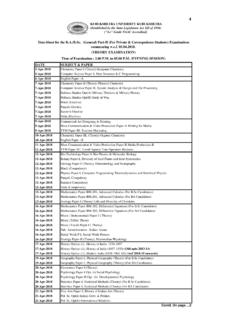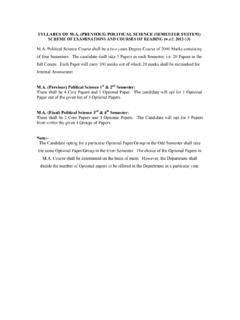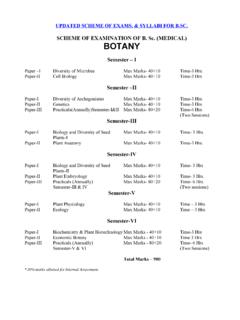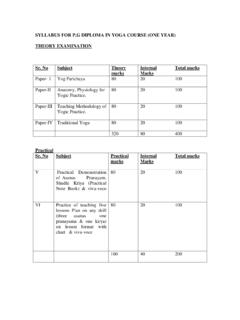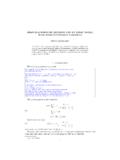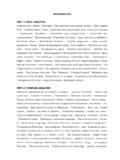Transcription of SYLLABUS FOR PHD ENTRANCE TEST - Kurukshetra
1 SCHEME & SYLLABUS FOR PHD ENTRANCE TEST IN MANAGEMENTT here will be two papers Paper-IObjective type: 50 MarksThis paper will consist of 50 objective type questions of 1 mark each related to basics of the prescribed SYLLABUS for ENTRANCE Test (Management). Time allotted for this paper will be 1 hour ( to Noon).Paper-IISubjective Paper: 100 MarksThis paper will consist of 12 subjective questions. The candidates will be required to attempt any 8 questions. Each question shall carry equal marks. Time allotted for the second paper will be 2 hours ( to ).1 DETAILED SYLLABUS FOR PAPER-I & IIBoth papers I & II will be set out of the SYLLABUS of the following compulsory papers of Management CP-101: Management Process and Organizational BehaviourEvolution of management thought : Systems and contingency approach for understanding organizations; Managia1 processes, functions, skills and roles in an organization; Social Responsibility of Business; Understanding and Managing individual behaviour; Personality; Perceptions; Attitudes; Learning; Decision-making; Management by Objectives; Understanding and managing group processes- interpersonal and group dynamics; Applications of Emotional Intelligence in organizations.
2 Leadership and influence process; Work Motivation. Understanding arid Managing organizational system Organizational design and structure, Work stress, Organizational Change and development; Conflict Management; Stress 102 : Business StatisticsUnivariate Analysis : An overview of central tendency, dispersion, aid Theory; Classical, relative and subjective probability,- Addition and multiplication probability models; Conditional probability and Baye s Distributions: Binomial, Poisson, and normal distributions; Their characteristics and applications. Sampling and sampling methods; Sampling and non-s Sampling erros s; Law of Large Number and Central Limit Theorem; Sampling distributions and their Estimation and Testing; Point and interval estimation of population mean, proportion, and variance; Statistical testing of hypothesis and errors; Large and small sampling tests Z, t and F Parametric tests : Chi-square tests ; Sign tests ; Wilcoxon Signed Rank tests ; Kruskal Wallis and Regression Analysis : Two variables Numbers : Meaning and types; Weighted aggregative indices-Laspeyre s and Paasch s indices; Laspeyre s and Paasth s indices compared, indices of weighted average of (price and quantity) relatives; tests of adequacy Special problems shifting the base; splicing, overlapping index series; Uses and problems of Index number; Time Series Analysis.
3 Trend Quality Control : Causes of variations in quality characteristics, Quality control charts, - purpose and. logic; Constructing a control chart computing the control limits (X and R charts); Process under control and out of control, Warning limits; Control charts for attributes -fraction defectives and number of defects Acceptance 103 Managerial EconomicsNature and scope of Managerial Economics. Importance of Managerial decision making; Marginal analysis; Objective of a firm, Demand function, Elasticity of demand and its significance in Managerial decision-making; Consumer equilibrium-utility and indifference curve approach; Price, income and substitution effects; Fundamentals of demand estimation and forecasting; Short-run and long-run production functions; Cost curves and economics of scale; Price and output determination under perfect competition, monopoly, monopolistic, competition, and oligopoly; Pricing strategies and tactics; National Income alternative concepts aid measurement of National income; Inflation types, measurement and control; Balance of Payments.
4 Monetary and Fiscal Business EnvironmentNature, components and determinants of business environment, dynamics of business environment, key indicators; Risk in business environment, Assessing business environment country risk and political state of business environment in India Economic reforms Liberalisation, privatisation, globalisation, industrial policy and industrialisation trends, public enterprise reforms and disinvestment programmes; competitive environment; financial environmentIndia s current balance of payment position, globalisation trends, Trade reforms & trends, FIJI poky & trends, India s share iii world economy. Trends in global trade & investment; Nature & operations of multilateral economic institutions- World Bank, WTO IMF and their impact on Indian business environment.
5 Factors of global 105 Business CommunicationImportance and nature of business communication, Effective communication skills; Process of 3communication Oral and Non-Verbal communication, Barriers and gateways in communication and Do s and Don t of business writing, Commercial letters; Writing business and academic reports; Public speaking, listening and Negotiations; conducting and attending interview and 106 : Accounting for ManagersFinancial Accounting - Meaning, scope and importance; Accounting concepts and conventions; Formation and importance of accounting Standards; Accounting process; Depreciation accounting and policy, Preparation of final accounts of non corporate entities, Proforma of Balance Sheet of Joint stock Companies, Cost-accounting : nature and scope of costing; Cost concepts and Classifications; Usefulness of Costing to Managers; Preparation of Accounting : Nature, scope and tools of Management Accounting; Management Accounting vs.
6 Financial accounting; Financial analysis, Ratio analysis, Funds-Flow Statement, Cash-flow StatementBudgeting: Types of budgets and their preparation, Performance budgeting and Zero-base costing : Break even analysis. Decision involving alternative Costing: An OverviewCP-107: Computer Applications in ManagementComputers: An introduction; Computes in business; Elements of computer system set-up; Indian computing environment; components of a computer system Computer languages; Number system PC- Software Packages - An Introduction - Disk Operating System and Windows; Introduction to Word Processor. Introduction to a spreadsheet software; Creation of spreadsheet applications; Range, Formulas, Functions, Data Base Functions in spreadsheet; Graphics on Spreadsheet; Data Files- Types/Organization; Master & Transaction File; Relevance of Data Base Management; Systems and Integration of Applications; Basics of Data Processing; Data Hierarchy & Data File Structures.
7 Network Fundamentals, Analog and Digital Signals, Band width, Network Topology, Network 108 : Management ScienceManagement Science - Basic concepts and its role in decision- making; Linear programming, meaning, scope & assumptions. Formulation of linear programming problem & solution by graphical & Simplex methods. Some special cases like degeneracy, unbounded ness, infeasibility and multiple optimal solutions. Sensitivity analysis. Integer programming, goal programming, dynamic programming and non-linear Programming. Transportation and Assignment models including trans-shipment and routing problems; Some special cases like minimization , unbalanced problems, degeneracy in transportation models. Queuing theory; Inventory management techniques; PERT/CPM; Decision theory and decision trees; Game theory; 109 : Marketing ManagementNature, scope and concept of marketing, Corporate orientations towards the marketplace; The Marketing environment and Environment scanning; Marketing information system and Marketing research; Understanding consumer and Industrial markets; Market segmentation, Targeting and positioning; Product decisions product mix, product life cycle, new product development, branding and packaging decisions; Pricing methods and strategies; Promotion decisions promotion mix, advertising, sales promotion, publicity and personal selling.
8 Channel management - Types and functions, Selection, Cooperation and conflict management, vertical marketing implementation and systems, Marketing Logistics; Organizing and implementing marketing in the organization; Evaluation and control of marketing efforts; Ethics in Marketing; New issues in marketing - Globalization, Consumerism, Green Marketing, Direct Marketing, Network Marketing, Event : Human Resource ManagementConcepts and Perspectives on Human Resource Management; Human Resources Management in a changing environment; Corporate objectives and Human Resource Planning; Career and succession planning; job analysis; Methods of manpower search; Attracting, Selecting and retaining human resources; Induction and socialization; Manpower training and development; Performance appraisal and potential evaluation; Job evaluation and compensation; Employee welfare; Industrial relations & trade unions; Dispute resolution & grievance management, Employee 111: Financial ManagementIntroduction to financial management Objectives of financial management; Time value of money, sources of finance, Investment decisions: Importance, Difficulties determining cash flows, methods of capital budgeting Risk analysis : Cost of capital; Concept and importance, Computations of cost of various sources of finance; Weighted Average Cost of Capital; Capital Structure decisions; Theories of capital structure, Factors determining capital structure.
9 Optimum capital structure; Management of working capital - Cash, Receivables and Inventory Management, Internal Financing and Dividend Policy; Financial : Business Research MethodologyNature and Scope of Research Methodology Problem Formulation and Statement of Research Objectives; Value and Cost of Information; Bayesian Decision Theory; Research Process; Research Designs - Exploratory, Descriptive and Experimental; Methods of Data Collection Observational and Survey Methods; Questionnaire and Interviews. Attitude Measurement Techniques; Administration of Surveys; Sample Design; Selecting an Appropriate Statistical Technique. Field Work and Tabulation of Data; Analysis of Data; Use of SPSS and other Statistical Software Packages Advanced Techniques for Data Analysis ANOVA. Discriminate Analysis, Factor Analysis, Conjoin: Analysis and Clustering : Production and Operations ManagementNature and Scope of Production and Operations Management; Facility Location; Types of Manufacturing Systems and Layouts; Layout Planning and Analysis; Material Handling : Principles & Equipments; Line Balancing; Production Planning and Control in Mass Production, in Batch and Job Order manufacturing; Capacity Planning; Product Planning and Selection, Process Planning, Aggregate Planning and Master Production Scheduling; Maintenance Management, Work Study : Method Study and Work Measurement, Material Management, Material Management; An Overview of Material Management, Material Requirement Planning and Inventory Control; JIT; Purchase Management; Stores Management.
10 Quality Assurance : Acceptance Sampling, Statistical Quality Control, Total Quality Management; 114: E CommerceIntroduction to Electronic Commerce: Framework, applications; network infrastructure (including internet). Internet payment system, inter-organizational commerce & intra organisational commerce, EDI, value-added network, digital library;Security, advertising & marketing on the internet, introduction to e consumer search & resource discovery, computer based education & training, digital of mobile computation and wireless computation, multimedia & digits] video, software agents; characteristics & properties, technology, tote script, agent language, applets & : Business Policy and Strategic ManagementAn Introduction to business policy Nature, Objective and importance of business policy; An overview of strategic management; Strategic decision making; Process of strategic 4ecision of planning systems - corporate planning, strategic planning and long range planning.
